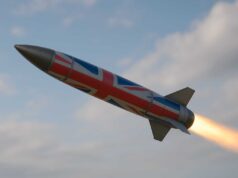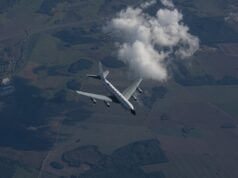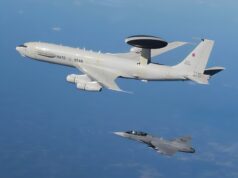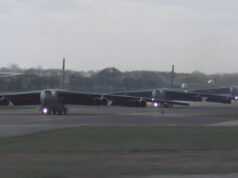A new report from the Council on Geostrategy has warned that critical gaps across European NATO militaries risk undermining deterrence against Russia, as decades of underinvestment collide with shifting global priorities and a more aggressive Moscow.
The study, titled Collective Defence, the SDR, and Capability Gaps, highlights shortfalls across air, sea, and land power, and argues that without urgent reform and integration, European allies could struggle to respond effectively to future crises on the continent.
The report includes a foreword by Gen. (rtd.) Sir Richard Barrons, co-author of the 2025 Strategic Defence Review, who warned that “hope and denial” had too often replaced coherent strategy in European defence planning.
The analysis identifies weaknesses ranging from limited missile defence capacity and slow production rates to inadequate counter-drone systems and shortfalls in anti-submarine warfare.
It also notes growing vulnerabilities in logistics and industrial resilience, with many NATO members dependent on commercial shipping and supply chains ill-suited for wartime demands. Barrons wrote that “we know what needs to be done. What is left is to decide to do it at the speed determined by the risks.”
Report author William Freer, a Research Fellow in National Security at the Council, said the study sought to provide “a clear picture of European NATO and its current capabilities stacked against a Russian military capable of posing problem sets that could challenge the foundations of the alliance.” He added that Russia’s military, once the war in Ukraine ends, will likely emerge with “a large infantry-based army, supported by a deep and replaceable long-range fires magazine, shielded by A2/AD systems and backed by a powerful nuclear arsenal.”
Among its recommendations, the report calls for a more focused UK force structure with greater emphasis on air and naval power, the expansion of missile production capacity, and consideration of a UK-built sub-strategic nuclear missile to bolster deterrence. It also urges closer integration among European allies to avoid duplication and address gaps more efficiently.
Freer noted that European navies are particularly vulnerable, with fewer than half of NATO’s surface warships commissioned in the past 15 years and none equipped for ballistic missile defence. Despite recent increases in defence spending, he warned that “gaps remain. It is vital that deterrence in the Euro-Atlantic continues to hold.”
The full report, Collective Defence, the SDR, and Capability Gaps, is available on the Council on Geostrategy’s website.














Recommend the wargame podcast. It brings into stark reality our failure in having missle defence
If a hafnium isomer warhead could be developed, that would give you a 4 to 6 kt explosion without any radioactive fallout. However, at the moment, the detonation method is the size of a ship, so not practical.
The W76-2 Trident warhead has a yield of around 7kt & is relatively clean by nuke standards. I often thought that a W76-2 inside a Paveway IV body & JDAM-ER wingkit, would be a simple way for the UK to get back into tactical nuclear weapons.
Yes it is a primary requirement of our nuclear deterrent and something I have been saying for a long time. Essentially our nuclear deterrent is a strategic second strike deterrent, designed to essentially prevent MAD from occurring by being able to deliver MAD..on the not so silly assumption that nobody would be stupid enough to trigger a MAD response against their nation.. now was long as you have enough warheads to trigger MAD and the other side does not think they can destroy your second strike capability with a counter force first strike your golden.
But there are a couple of issues that have now cropped up that are a problem..
Russian nuclear doctrine and wider military doctrine now follows the escalate to deescalate paradigm. This more than slightly risky paradigm says if you force a higher step in the escalation ladder it will force your enemies to back down because they will not want to escalate further and if they cannot match your escalation then you are free to take this step.. essentially what this means in a nutshell is that Russia has come to the conclusion it can get just maybe get away with a tactical nuclear response due to the characteristics of the three NATO nuclear powers.
1) The UK, it’s probably the NATO nuclear power that would be most willing to respond to a tactical nuclear strike.. because it’s always made it clear that it’s Nuclear forces are at the service of NATO and it has battle groups in places that are likely to be affected. Essential it has skin in the game and has shown willingness and total commitment to NATO.. the problem is it does not have any sub strategic weapons to respond with as it has a single strategic platform on patrol that it could never compromise with a single sub strategic launch.. essentially the UK nuclear response is nothing or MAD this plays into the hands of the Russian escalate to deescalate.. we have the will but not the means. Also at preset the UKs ability to undertake a full MAD exchange with Russia is also just on the edge and the number of strategic warheads would need to be closer to 100 to destroy every Russian city of significance and kill it as a nation.
2) the U.S. well there are no holes in the US nuclear deterrence it could easily provide any graduation of response and kill Russia 5-10 times over. But the fundamental question here is will.. would a modern US president in an administration that does not like Europeans much and only considers immediate U.S. needs even consider escalation or a nuclear response..I suspect Putin probably thinks not.
3) France is the one European nation that has a sub strategic response and could escalate or respond without resorting to MAD with any number of air launched sub strategic weapons…but it’s always been clear that its nuclear weapons are for the sole purpose of defending France… its moderating that a bit.. But would Putin believe.
So we have a situation where rightly or wrongly Putin may think that the only nation that would probably respond to a tactical nuclear strike in Eastern Europe with a sub strategic response could not actually respond and so he may just be stupid enough to try.
That’s why either the US and France needed to far more steely eyed and spray that red line on the floor or the UK needs to step up with a sub strategic response.
Now to be very clear this is not suggesting the UK get tactical nuclear weapons as these are weapons that are not a deterrent but are instead designed to be used as part of the tactical battlefield.
tactical nukes are outdated cold war era thinking. there won’t be massed tank divisions to target, everything is dispersed now.
that said UK should develop its own air launched nuclear cruise missile. (because gravity bomb to Moscow is pie in the sky) also having nuclear RAF squadrons going to alert is usefull as a final warning without having to launch the apocalypse. much harder to do that with a SSBN, since it would have to surface and reveal its position to send a message.
The latest I hear in NMH New Medium Helicopter program is that it may have collapsed down to less than 20 helicopters.
TWENTY. The requirement was for 44.
And we talk of developing Cruise missiles!
AUKUS phase 2, DNE renewal works, Dreadnought, and Tempest all exist and will drain any spare money away.
budgets are supposed to increase, at least that was what was promised at last major NATO summit.
as far as developping a cruise missile, I don’t think that would break the bank compared to buying and maintaning F35 + B61 as well as retrofit Voyager with boom. The Stratus Hi and Lo are currently in development So it xould be feasible to have a Typhoon T4 carrying a version of Status Hi or Lo missile with a nuclear warhead with a range of approx 500km. Germans are also developing an EW pod with Saab for Typhoon which should allow limited penetration of Russian airspace.
my 2 cents
FYI Stratus Lo has approx range of 1,500km while Stratus Hi is about 800km, meaning you could target Moscow without having to penetrate Russian airspace and stay within friendly airspace.
So the NMH morphed into 20 AW139 to replace 23 Pumas, half a dozen H145s and some shuffling around. Maybe we will get a few more Merlins?
They have seen we have muddled along without them so to their way of thinking we don’t need them!
Hi M8 Cost curves on DNE renewal and Dreadnought are at or just past their maximum expenditures. As for AUKUs just remember we aren’t doing this for nothing, it is actually a Net income earner for U.K. PLC. It’s better than you think ! But the Political element is 🤷🏼♂️
Hi mate.
Fair comments. I’m not against AUKUS, or Tempest, but I do see how they drain the budget along with everything else this charade of a government are shoving into the budget.
And if the expenditures on DNE, Dreadnought, are going to fall then maybe there’s some extra money!
Until the SIA of over 4 billion is added to the 2.5% from 2026 eh!😆
Until HMG remove Chagos payments, Afghan rehoming, Ukraine money, and all other interests feasting at the defence table who have no right to be there, where is the money for this?
Let alone conventional defence capabilities which continue to erode unabated despite HMG grandstanding and spin.
All these calls by think tanks, retired top brass who kept their mouths shut until out of office and safe in their pensions, and others have no impact whatsoever on a government which simply isn’t interested beyond industrial impacts and the chance to act the power on the world stage for political reasons.
DM, you could also cut the £20 billion for a hole in the ground (alleged unproven carbon capture), subsidies for electric cars & heatpumps. I fear Starmer is alltalk on extra defence spending, but Rachel has b*gg*r*d the economy, so there is no extra money to spend on defence.
Hi M8, As Jonathan has very ably argued a Tactical Nuclear option doesn’t have to cost a fortune, if there is one thing the U.K is good at it’s repurposing existing systems and improvising.
That can range from a simple Free Fall or Toss Delivered Bomb to a version of Storm Shadow, the warheads already exist ! If it was me I’d go for a short term minimal cost improvised capability and speak to France about cooperation on a more comprehensive modern system.
As it stands at the moment all Russia has to do is carry out a Tactical Nuclear Strike on NATO targets, avoid hitting the French or Americans and tell both of them to sit it out or else.
But it all comes down to money and Starmer, he needs to grow a pair. He is steeped in Labour History so someone should sit him down and remind him that Labour under Atlee actually (and secretly) paid the bill to develop the UK A Bomb in just 5 years. Meanwhile they were busy founding the NHS and we as a country were skint and still on rationing.
Read Churchill’s memoir, he got a hell of a pleasant shock when he won in October 1951 and found out we busily building an A bomb but buying all delivery systems and due to Test it less than a year later.
FYI nearly all our Nuclear weapons related sites were started by Labour between 1946 and 1951.
Bring back Clement Atlee and Ernest Bevin !
Hi mate.
Yes, but the working class Labour then and those class war zealots in power now I suggest are two very different things.
Just like Scotland was once a Tory stronghold…proper Tories, not the current generations.
As it stands, Starmer I don’t think is capable of growing a pair of anything, and has the look of a man terrified of his own shadow, never mind the left of his party.
All fantasy that I won’t ever believe under this government mate, sorry. As you’ve said before, they’re ordering next to nothing.
And for balance, the absolute shower of the one before this lot as well.
“…Ukraine money, and all other interests feasting at the defence table…”
So DM would you prefer ruZZia to win in Ukraine, and bring war into the heart of Europe, which will cost us way more then 5% of GNP to defend against? Russia has always been a rival empire to Britain, and always will be as long as it exists. An opportunity was lost in the 1990’s to break it up smaller.
Did I say that?
I either want the 3 billion plus Ukraine money to cone from the aid pot, not our Conventional forces budget. Or, I want it repaid in full ftom HMT.
Someone, plesse, give me proof that HMT repay the MoD those 3 billions plus?
I’ve not seen any evidence, and Ben Wallace himself I understand complained about it as he wouldn’t accept it when he was in office.
So, MerionX, do you see where I am coming from?
Most of the earlier aid given to Ukraine was from MoD warpons stocks, which should of have ordered newer replacements, with extra funding from The Treasury, which only party did so. Yes, Daniele you are right, the current aid to Ukraine is in the form of Industrial warpons production ventures coming out of the MoD budget, which should be refunded from The Treasury.
“Should”
Yes, we know.
We aren’t buying it without solid gold proof however, because there’s virtually nothing that the Government hasn’t lied about these past few years.
Where do we think the money for this will come from? More cuts in conventional defence? Until the military is much better financed, this is a dangerous fantasy.
You might start by removing the F-35A/American dumb bomb order recently placed. That might go some way, actually.
In regards to the last statement, did they mean no European ship has ballistic missile defence or none commissioned in the last 15 years. As the Type 45 has used a Aster-30 to shoot down a ballistic missile in test.
This validates a lot of my rhetoric on here lately.
We need a French approach to our nuclear deterrence. Trident is fundamentally flawed in that it depends on Russian sympathisers for its long-term serviceability. We need home-grown warheads, put on target with home-grown delivery vehicles.
The way things are going, the Americans are more likely to roll out a red carpet for the Russians, than they are to provide a credible nuclear deterrence against them.
I appreciate that I come across overtly on this particular subject, but we can’t understate the importance of getting this bit right. It’s quite literally life and death.